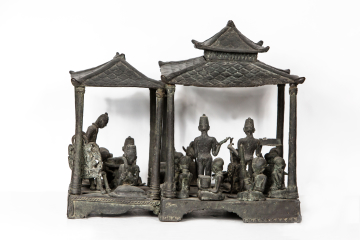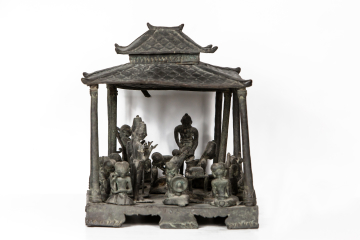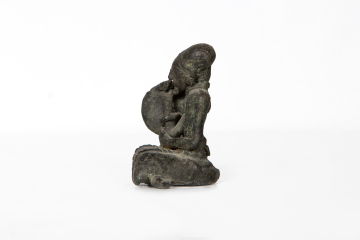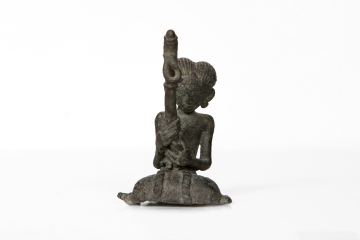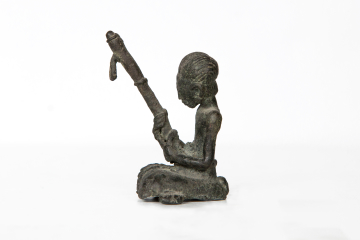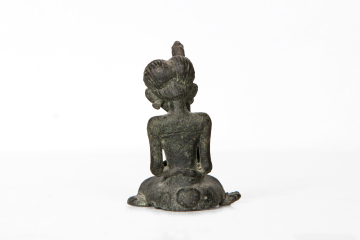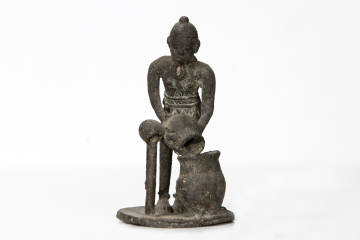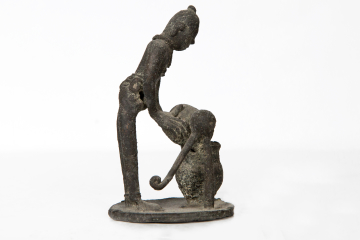Explore Collections


You are here:
CollectionsOnline
/
A pavilion with figures (Javanese), perhaps made as a gift for a colonial administrator, late 18th or early 19th century
Browse
A pavilion with figures (Javanese), perhaps made as a gift for a colonial administrator, late 18th or early 19th century
Copper-alloy
Museum number: HR21
On display: Picture Room Recess (pre-booked tours only)
All spaces are in No. 13 Lincoln's Inn Fields unless identified as in No. 12, Soane's first house.
For tours https://www.soane.org/your-visit
Curatorial note
The Soane Museum AB inventory, 1837, describes this as 'A small Pavillion, with a variety of Figures seated, some playing on Musical Instruments, others engaged in different domestic occupations, brought from Java by Mr Layard. Bronze'. In the 'Visitors' copy of the same inventory, also dated 1837, George Bailey (the first Curator) has added the note '(as stated by him 9 April 1847. G[eorge] B[ailey]'. In Soane's Library (G14D) is the book Graecae sententiae e variis Graecrum ...., 1758, with inscriptions indicating that it belonged to a Charles Peter Layard from 1761. The obvious connection for this bronze would be with his grandson, the famous archaeologist Sir Austen Layard (1817-94), excavator of Nimrud and of Nineveh, but this cannot be the case: Austen Henry was only only 20 at the time of Soane's death and did not travel out to the east until 1839 (and then not to Java). It seems that Austen Henry cannot be the Mr Layard who visited the Curator in April 1847 as according to the DNB he was overseas, returning to London only in December 1847.
Dr Ian Glover, Institute of Archaeology, UCL, provided the following detailed description of the pavillions (1996):
'Two small copper-alloy pavillions believed to be from Java ..... Little is known about these items. The pavillions, which differ in some decorative details around the base, were made separately, but are now fixed together and contain about 20 standing, sitting and kneeling figures, each separately cast and pegged to the base plates. It is possible that the figures could be moved to different positions originally but with the exception of the tallest standing figure, they are now rather corroded into position.
Some figures seem to be musicians, as described in the catalogue [1837 inventory], although there is no gamelan orchestra which might be expected, and others are variously washing clothes, presenting something on a tray to a man holding a kris, holding a mallet and pouring a liquid into a vase. From the style of the chair on which the man in the smaller pavilion is sitting and the fez-like hats worn by the standing men amongst others, I guess that the models were made something between the late 18th to early 19th century; but exactly where, when, for, and by whom is not known. Were they a form of 'dolls' house' made for a foreign traveller as a memento of his visit, or did they serve some function within Javanese society?'.
Java, an island of Indonesia, was under the control of the Dutch East India Company during the period when these pavillions are thought to have been made. For a brief period coinciding with the Napoleonic wars in Europe, Java was controlled by the French but in 1811 it was captured by the British and became briefly part of the British Empire with Sir Stamford Raffles as Governor. In 1814 it was returned to the Dutch under the Treaty of Paris and remained under Dutch rule until independence in 1949.
Dr Ian Glover, Institute of Archaeology, UCL, provided the following detailed description of the pavillions (1996):
'Two small copper-alloy pavillions believed to be from Java ..... Little is known about these items. The pavillions, which differ in some decorative details around the base, were made separately, but are now fixed together and contain about 20 standing, sitting and kneeling figures, each separately cast and pegged to the base plates. It is possible that the figures could be moved to different positions originally but with the exception of the tallest standing figure, they are now rather corroded into position.
Some figures seem to be musicians, as described in the catalogue [1837 inventory], although there is no gamelan orchestra which might be expected, and others are variously washing clothes, presenting something on a tray to a man holding a kris, holding a mallet and pouring a liquid into a vase. From the style of the chair on which the man in the smaller pavilion is sitting and the fez-like hats worn by the standing men amongst others, I guess that the models were made something between the late 18th to early 19th century; but exactly where, when, for, and by whom is not known. Were they a form of 'dolls' house' made for a foreign traveller as a memento of his visit, or did they serve some function within Javanese society?'.
Java, an island of Indonesia, was under the control of the Dutch East India Company during the period when these pavillions are thought to have been made. For a brief period coinciding with the Napoleonic wars in Europe, Java was controlled by the French but in 1811 it was captured by the British and became briefly part of the British Empire with Sir Stamford Raffles as Governor. In 1814 it was returned to the Dutch under the Treaty of Paris and remained under Dutch rule until independence in 1949.
Soane collections online is being continually updated. If you wish to find out more or if you have any further information about this object please contact us: worksofart@soane.org.uk


